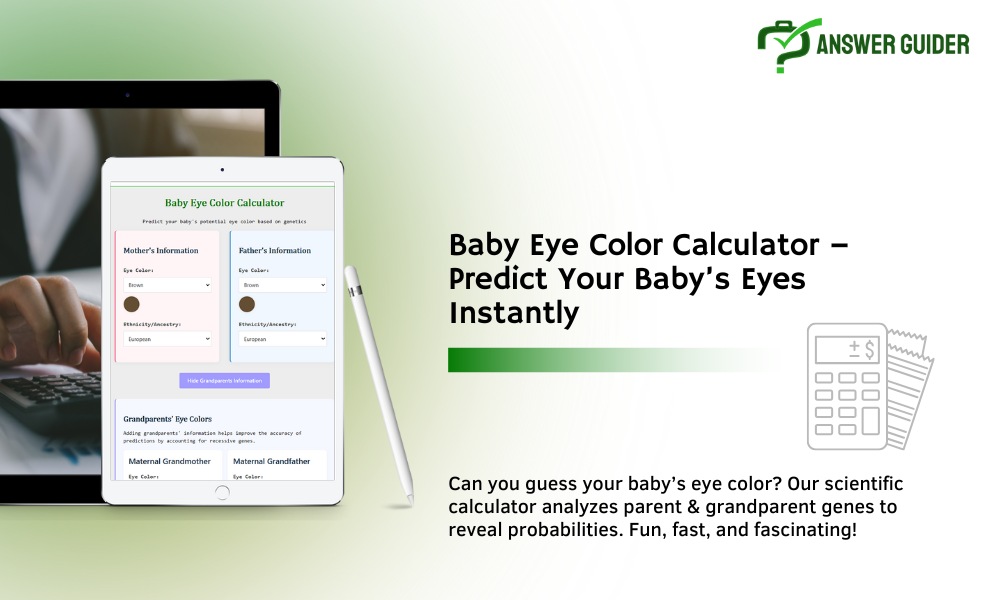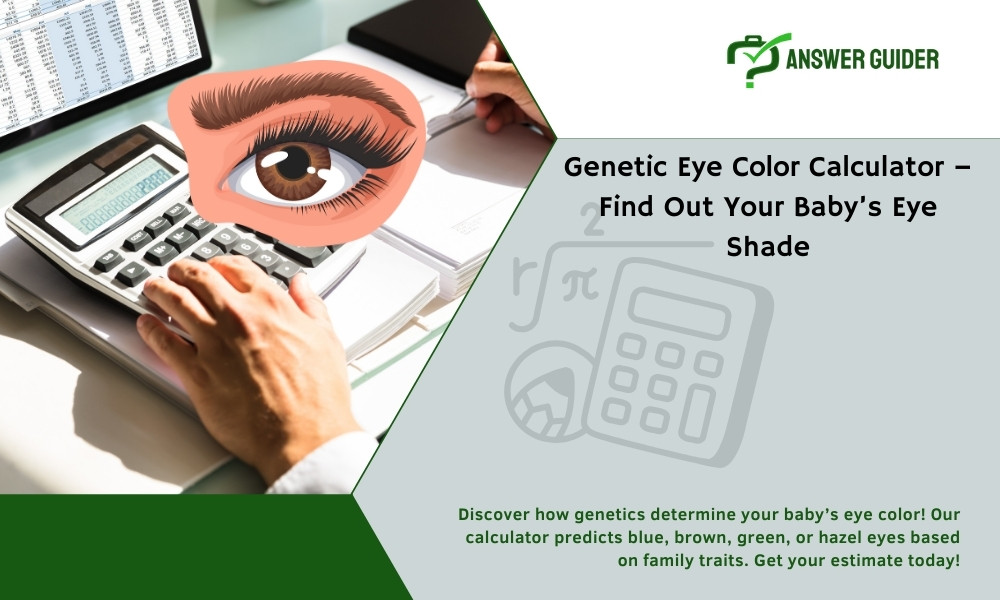Contents
We developed a baby eye color calculator for genetics and probability to give you a fun and educated guess. Have you ever wondered what color eyes your baby will have? It’s one of the most common questions expecting parents ask. Our eye color calculator helps you find your eye color’s genetic shape and get the most accurate prediction for your baby.
Baby Eye Color Calculator
Predict your baby's potential eye color based on genetics
Mother's Information
Father's Information
Grandparents' Eye Colors
Adding grandparents' information helps improve the accuracy of predictions by accounting for recessive genes.
Maternal Grandmother
Maternal Grandfather
Paternal Grandmother
Paternal Grandfather
Your Baby's Potential Eye Colors
Based on the genetic information provided, here are the probabilities of your baby having different eye colors:
Genetic Explanation
How Eye Color Inheritance Works
Eye color inheritance is complex and involves multiple genes. The main gene is OCA2, which determines the amount of melanin in the iris.
While traditional genetics suggested that brown eyes are dominant over blue eyes, modern science has shown that eye color inheritance is more complex and involves multiple genes.
Common Eye Colors
Brown
Amber
Hazel
Green
Blue
Gray
Important Notes:
- A baby's eye color can change during the first year of life, typically darkening as melanin production increases.
- This calculator provides estimates based on genetic probability, not guarantees.
- Heterochromia (different colored eyes) is rare but possible and not predicted by this calculator.
- Ethnicity plays a role in eye color distribution in populations but doesn't directly determine an individual's eye color.
- Some babies are born with blue eyes that change to brown, green, or hazel by 6-12 months of age as melanin develops.
- In rare cases, eye color can change during adolescence or adulthood due to various factors.
What Is a Baby Eye Color Calculator?
Our newborn eye color predictor enables parents to predict their child’s eye color based on the eye color of the biological and sometimes even the grandparent’s eye color. The prediction is formulated from parental probability and simple Mendelian genetics.
In most cases, the parents can choose between blue, green, hazel, and brown and select the eye colors. The chances of the baby being born with any of the selected shades will be provided by the calculator.
Why Use a Baby Eye Color Calculator?
- Fun & Curiosity: It’s exciting to imagine what your child might look like.
- Educational: Learn how genetics influence physical traits.
- Family Bonding: A fun activity to share with partners, siblings, or grandparents.
While not a medical tool, it’s a light-hearted and informative way to engage with your child’s genetic possibilities.

How to Use Our Baby Eye Color Calculator
Predicting your baby’s eye color is an exciting way to explore genetics before your little one arrives! Our eye color determination calculator uses parental and grandparental eye colors to estimate the most likely outcomes. Here’s a step-by-step guide on how to use it for the most accurate prediction:
Step 1: Enter the Mother’s Eye Color
- Select the mother’s eye color from the dropdown (e.g., brown, blue, green, hazel, gray).
- If you know, input her ethnicity/ancestry (e.g., European, Asian, African), as this can influence genetic probabilities.
Step-2: Enter the Father’s Eye Color
- Choose the father’s eye color from the same options.
- Add his ethnic background to our calculator, which allows for better accuracy.
Step-3: (Optional) Include Grandparents’ Eye Colors
For a more precise prediction, you can input:
- Maternal grandparents’ eye colors (mother’s parents).
- Paternal grandparents’ eye colors (father’s parents).
Why? 3 generation eye color calculator helps detect hidden recessive genes (e.g., a brown-eyed parent carrying a blue-eye gene from a grandparent).
Step 4: Click “Calculate Baby’s Eye Color”
- The calculator will process the genetic combinations and display probabilities.
How Accurate Are Baby Eye Color Calculators?
While genetics-based calculators provide a reasonable estimate, they can’t guarantee the exact outcome. Factors like multiple gene interactions and random mutations can affect results.
For the most accurate prediction:
✔ Use a calculator that considers both parents and grandparents.
✔ Remember that probabilities are not certainties.

Tips for Best Results
- Use complete family history (parents + grandparents) for higher accuracy.
- Remember: Eye color can change in the first 1-3 years.
- No calculator is 100% accurate—genetics can be unpredictable!
Also, You can use those calculators:
Free BTZ Calculator for Air Force Promotions
Free Chiron Calculator | Find Your Astrological Insights
Destiny Matrix Calculator – Fast, Insightful & Easy Use
Free Pain and Suffering Calculator | Know Your Injury Worth
Asphalt Calculator: Estimate Your Asphalt Needs & Costs
Conclusion:
Eye color is a mysterious, beautiful trait that reflects generations of ancestry and genetic interplay. While we can’t predict with certainty, our Baby Eye Color Calculator offers a delightful and science-backed way to engage in the guessing game.
Whether you’re just curious, preparing your baby book, or sharing a fun moment with family, try our calculator!
FAQ
3 Generation Eye Color Calculator?
A 3-generation eye color calculator can improve prediction accuracy by including grandparents’ eye colors. While most basic calculators only use parent data, more advanced tools like ours can help factor in multigenerational genetics to estimate your baby’s possible eye color better.
Punnett Square Eye Color predictor?
A Punnett square is a classic genetic tool for predicting traits like eye color. However, it only works well with simplified dominant-recessive models. Since eye color is polygenic (influenced by multiple genes), our baby eye color calculator uses probability models beyond basic Punnett squares for a more realistic prediction.
Eye Color Calculator With Grandparents?
Including grandparents adds another layer of accuracy, especially if their eye colors differ from the parents’. While not all calculators support this, our tool encourages considering family history to estimate better how traits may carry through generations.
Baby Eye Color Calculator With Hazel?
Hazel eyes fall between green and brown on the melanin spectrum and can be harder to predict. Our calculator includes hazel as an option and factors it into probability estimates to give you a more personalized result when hazel runs in your family.
Eye Color Calculator With Great Grandparents?
Very few calculators allow for great-grandparent input due to genetic complexity. However, if you know their eye colors, you can consider those traits part of your family history. For best results, use our calculator with both parent’s and grandparents’ eye colors for a stronger estimate.
Eye Color Predictor Chart?
Our eye color charts offer a visual guide for inheritance patterns, but they’re often based on older models. Our modern calculator goes beyond static charts by dynamically calculating probabilities based on real genetic patterns. It’s more interactive, fast, and informative than traditional eye color predictor charts.

